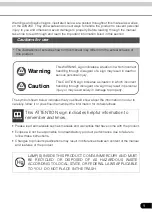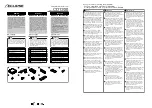
LINEAR’S MULTI-CHANNEL RECEIVERS
Linear manufactures several multi-channel receivers for
use in security systems and remote switching functions
requiring more than one wireless zone or output. Using one
multi-channel receiver instead of several single-channel
receivers enables the installer to cut installation costs and
improve system performance by eliminating RF
interference problems present in multiple-receiver
installations.
THREE DIFFERENT TYPES OF OUTPUTS
Linear’s two- and four-channel receivers are available in
three different types of output configurations: two
solid-state and one relay. Certain alarm control panels and
communicators require a positive voltage to trigger. Other
controls, especially those with end-of-line (EOL) resistors,
can be triggered with a short-to-common output. All
controls and communicators can be triggered with a dry
contact relay output (normally open or normally closed).
“C” TYPE VOLTAGE OUTPUT
D-4C and D-4C/K
The output wires on the “C” type voltage output receivers
supply a positive trigger voltage to the connected device
when the receiver detects a properly coded digital RF
signal from a Linear transmitter. Each output channel wire
will switch from an open state to +9 volts DC when
activated. The voltage outputs are current limited to 10 mA
maximum at 9 VDC, 40 mA maximum into a short. See
Figure 1 for a hook-up example.
“D” TYPE SHORT-TO-COMMON OUTPUT
D-4D and D-4D/K
The outputs of a “D” type short-to-common receiver are
similar to a normally open switch that has one side
connected to common or circuit ground. When any receiver
channel is activated, the corresponding output wire will
switch from an open state to 0 volts (common or circuit
ground). The short-to-common outputs are current limited
to a maximum of 40 mA. This is enough current to trigger
most control panels with EOL resistors or drive a small
relay. If driving a relay, be sure to connect a clamping diode
across the relay coil. See Figure 2 for a hook-up example.
✶
NOTE: On all “C” and “D” type receivers, the common (-)
of the receiver must be connected to the common (-) of the
control panel or communicator (see Figures 1 & 2).
“R” TYPE RELAY OUTPUT
D-2R, D-2R/K, D-4R AND D-4R/K
The outputs of the “R” type receivers are isolated dry relay
contacts. Dry contacts indicate that the switching contacts
are isolated from the receiver power supply. The receivers
provide normally open and normally closed contacts for
each channel. The current rating of the relay outputs is 1
amp at 32 volts maximum. Do not exceed this rating. See
Figure 3. for a hook-up example.
RECEIVER CODE SETTING
✶
CAUTION: Transmitters and receivers should be re-coded
by the installer prior to installation. Do not leave units set
to the factory code.
Linear’s two- and four-channel receivers contain an
eight-key digital coding switch recessed in the back cover
of each unit.
The switch keys are numbered 1-8 (see Figure 4). Keys
#1 and #2 are not used when coding the receiver. These
keys are not connected, and their position doesn’t matter.
To set a code, select a random pattern for keys 3-8. Set
the code keys with a pointed object other than a pencil or
pen. In the example shown in Figure 4, keys 4, 6 and 7 are
set to
ON, keys 1, 2, 3, 5 and 8 are set to OFF.
The receiver code keys 3-8 must match exactly with code
keys 3-8 in all Linear transmitters used with that receiver.
TRANSMITTER CODE SETTING
TWO- AND FOUR-CHANNEL TRANSMITTERS
To code a D-4 four-channel portable transmitter to any two-
or four-channel receiver, simply match keys 3 through 8 in
the transmitter to keys 3 through 8 in the receiver.
To code D-22B, D-22C, or D-22D two-channel portable
transmitters to a two-channel receiver, match keys 3
through 8 in the transmitter to keys 3 through 8 in the
receiver and turn transmitter key #2 to the
OFF position.
✶
IMPORTANT: When using the above two-channel
transmitters with any two-channel receiver, key #2 in the
transmitter must be
OFF.
To code D-22B, D-22C, or D-22D two-channel portable
transmitters to a four-channel receiver, match keys 3 through
8 in the transmitter to keys 3 through 8 in the receiver. If key
#2 in the transmitter is
OFF, the transmitter will activate
receiver channels one and two. If key #2 in the transmitter is
ON, the transmitter will activate channels three and four.
SINGLE-CHANNEL TRANSMITTERS
To code any Linear single-channel transmitter to a two- or
four-channel receiver, set keys 3 through 8 in the transmitter
to match keys 3 through 8 in the receiver. Keys one and two
in the transmitter determine which receiver channel will
activate. Refer to Figures 5, 6, 7 and 8 for the settings of keys
one and two in the transmitter for selecting channels 1, 2, 3
and 4 respectively.
✶
NOTE: On multi-channel receivers, only one receiver
channel can be activated at a time!
Codesetting Instructions for D-2&4 Rcvrs
Linear P/N 106226 B
Size: 17.0" W x 5.5" H
Material: 70 Lb. White Coated
Ink: PMS 285 (Blue) & Black
1 of 2
Codesetting Instructions for D-2&4 Rcvrs
Linear P/N 106226 B
Size: 17.0" W x 5.5" H
Material: 70 Lb. White Coated
Ink: PMS 285 (Blue) & Black
1 of 2
+ 12 VDC AUX OUTPUT
COMMON NEGATIVE
COMMON LOOP RETURN
ZONE 2 INPUT
TYPICAL CONTROL PANEL
ANTENNA
"C" TYPE
RECEIVER
CH 1
CH 2
RED
BLACK
VOLTAGE OUTPUT HOOK-UP
ZONE 1 INPUT
+9 WHEN TRIGGERED
ZONES PROGRAMMED
FOR VOLTAGE TRIGGER
Figure 1. Typical "C" Type Wiring
+ 12 VDC AUX OUTPUT
COMMON NEGATIVE
COMMON LOOP RETURN
ZONE 2 INPUT
TYPICAL CONTROL PANEL
ANTENNA
CH 1
CH 2
RED
BLACK
ZONE 1 INPUT
"D" TYPE
RECEIVER
SHORT-TO-COMMON HOOK-UP
ZONES PROGRAMMED
FOR E.O.L. RESISTORS
COMMON WHEN
TRIGGERED
Figure 2. Typical "D" Type Wiring
+ 12 VDC AUX OUTPUT
COMMON NEGATIVE
COMMON LOOP RETURN
TYPICAL CONTROL PANEL
ANTENNA
CH 1
CH 2
RED
BLACK
"R" TYPE
RECEIVER
RELAY OUTPUT HOOK-UP
ZONES PROGRAMMED
FOR E.O.L. RESISTORS
N/O
COM
N/C
COM
ZONE 1 INPUT
ZONE 2 INPUT
Figure 3. Typical "R" Type Wiring
5
8
7
6
1
4
3
2
O
F
F
O
N
Figure 4.
Example
Coding Switch
O
N
O
F
F
1
2
3
4
5
6
7
8
Figure 5.
Transmitter Setting
for Channel One
O
N
O
F
F
1
2
3
4
5
6
7
8
Figure 6.
Transmitter Setting
for Channel Two
O
N
O
F
F
1
2
3
4
5
6
7
8
Figure 7.
Transmitter Setting
for Channel Three
O
N
O
F
F
1
2
3
4
5
6
7
8
Figure 8.
Transmitter Setting
for Channel Four




















